Travertine Countertops Review and Buyer’s Guide
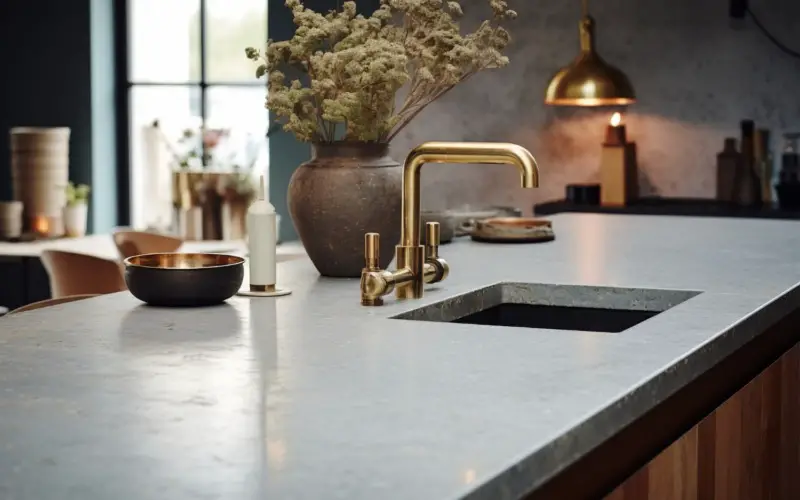
Travertine countertops are prized for their elegantly rustic appearance and range of warm, Old World colors. Like marble, travertine has been a popular surface material in homes and commercial buildings worldwide for centuries. Are you considering travertine countertops in your home? There many things to consider before installing this richly storied countertop material. In this guide, you’ll learn all about travertine countertops: pros & cons, available colors, cost, durability, and cleaning.
ON THIS PAGE
What Is Travertine?
Travertine is a natural stone that’s similar to limestone and marble. It has been used as an architectural building material for centuries and is a popular choice for countertops, tile and flooring in kitchens and bathrooms. This unique stone forms around hot springs out of calcium carbonate (calcite) and other mineral deposits that create soft colors and patterns. The holes commonly seen in travertine come from hot gases bubbling through the soft travertine as it formed over the millennia. Fabricators fill these holes to create a smooth, even surface for travertine countertops and floors.
Travertine countertops are made from large travertine blocks, a natural stone sourced from quarries in Italy, Mexico, Turkey, China, Iran, and Peru. The blocks are cut into travertine slabs and shipped all over the world. In Italy, travertine is a historic building material used for common buildings and monuments as ancient as the Roman Colosseum. Travertine’s natural color ranges from creamy ivory to pinky-tan, warm beige, and shades of brown.
In addition to travertine countertops, this stone is popular both indoors or outdoors for all the following uses:
- Interior floors
- Backsplashes
- Countertops (slabs or tile)
- Shower walls & flooring
- Bathtub surrounds
- Bathroom floors
- Kitchen flooring
- Fireplace Surrounds
- Tables
- Pool decks and coping
- Patios
- Walkways
- Interior and Exterior Wall Tile
- Driveways
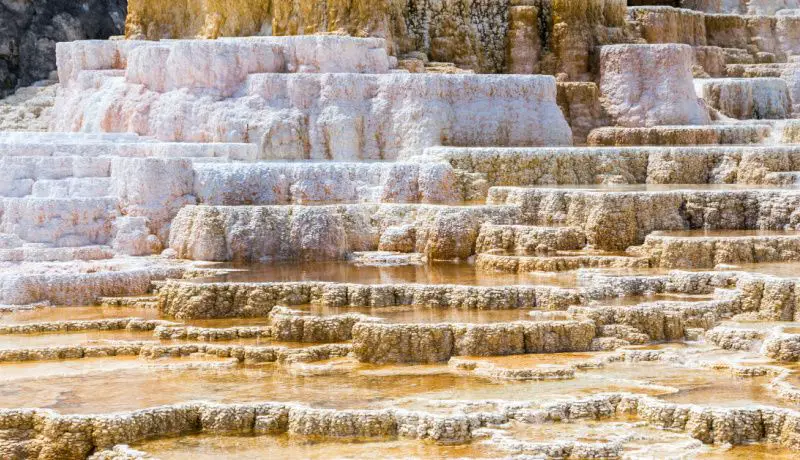 Travertine formation and mineral pools - Yellowstone National Park, USA
Travertine formation and mineral pools - Yellowstone National Park, USATypes of Travertine Stone
Travertine stone is available in three different grades. The different grades indicate color consistency, the number of filled holes, and the price. The actual performance and durability of each grade are essentially the same; homeowners can choose the grade that fits their desired appearance and budget.
- First Choice (or Premium): Travertine stone has a consistent color with little filler. Most travertine in this class comes from Italy and is the most expensive. However, Premium quality isn’t always necessary to achieve an appealing design.
- Standard: This grade has a greater variation in travertine slab color with a bit more filler. It is the most common grade of travertine. Most travertine countertop material in home improvement stores or stone warehouses will be standard grade that comes from quarries in Turkey.
- Commercial: This grade has lot more color variation and more extensive filler use. It is used mainly for outdoor applications like wall cladding on commercial buildings. However, some commercial grade travertine is near “Standard” quality and perfectly fine for residential use.
If you prefer a consistent color across all travertine countertops and a more sleek and refined look, go with a First Choice or Premium grade of travertine.
Pros and Cons of Travertine Countertops
Before choosing travertine countertops, homeowners should consider all of the pros and cons of this classic countertop material.
Travertine Countertop Pros
- Timeless Appearance: Travertine has an aged, rustic appearance that never goes out of style.
- Affordable Cost: Travertine is typically less expensive than marble or granite, although prices vary according to quality.
- Durability: Like any natural stone, travertine is heat resistant and durable. Proper care and cleaning of travertine will keep travertine countertops looking good for decades.
- Versatile: Travertine countertop material is suitable for kitchens, backsplashes, and bathroom countertops.
- Multiple Finish Options: Four surface finish options (polished, honed, brushed, and tumbled) provide different textures, appearances, and traction.
- Easy to Shape: Travertine slabs can be cut and shaped relatively easily, allowing for more ornate backsplash designs.
- Repairable: Nearly all damage to travertine is repairable. Stains and etching can be removed, cracks filled, and the surface refinished to like-new condition.
Travertine Countertop Cons
- Regular Maintenance: Travertine countertops can scratch, etch, or stain so they require more maintenance than other countertop materials like granite. To prevent stains, clean up any spills as soon as they happen.
- Frequent Sealing: Honed, brushed and tumbled travertine finishes require resealing more often than polished countertops. Polishing the surface closes the pores for a more stain-resistant surface.
- Holes Need Filling: Holes and gaps in the surface are a natural characteristic of travertine. Epoxy filler or grout create a smooth, cleanable surface and improve durability.
- Highly Susceptible to Acids: Travertine is made of calcium carbonate, which will react with any acidic substance, food, drink, or caustic chemical to etch dull spots on the finish. For messy cooks, travertine is not a good choice for a kitchen countertop.
Travertine Countertop Colors
The colors of travertine typically range from tan or ivory to honey, pink-beige and walnut brown. Rarer and more expensive colors include silver, burnt orange, red, or gray-green (if cyanobacteria, a blue-green algae, was present during formation).
Today’s most popular travertine colors are beige or ivory and gold. With gray shades trending out of home decor, travertine is a great option for updated interiors with warm neutral tones like ivory, walnut, and classic tan. In fact, Ivory Travertine and Noce Travertine are top sellers in 2025.
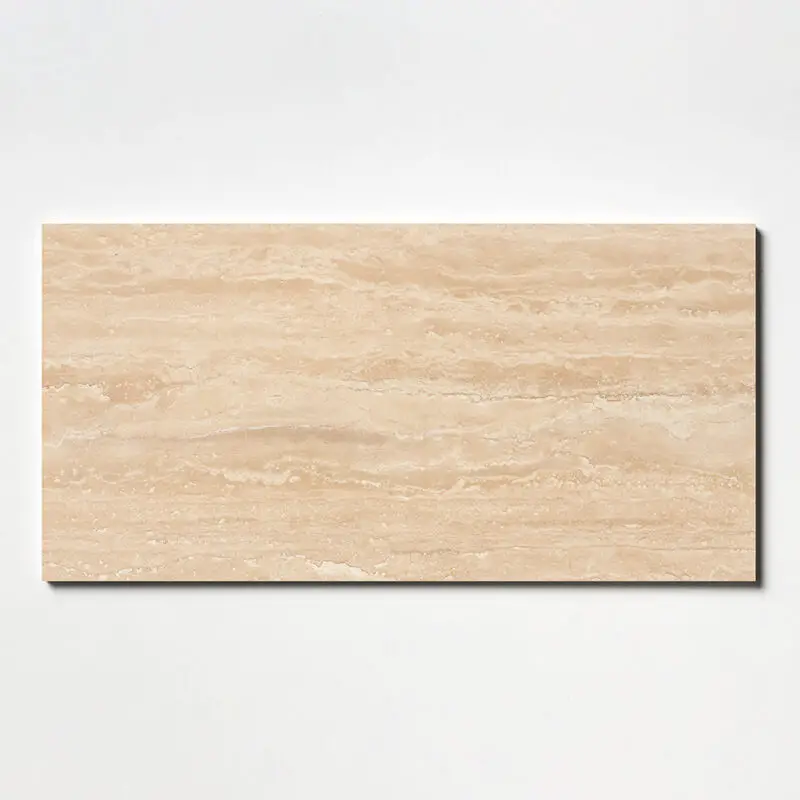 Ivory Vein Cut Travertine, Marble Systems
Ivory Vein Cut Travertine, Marble Systems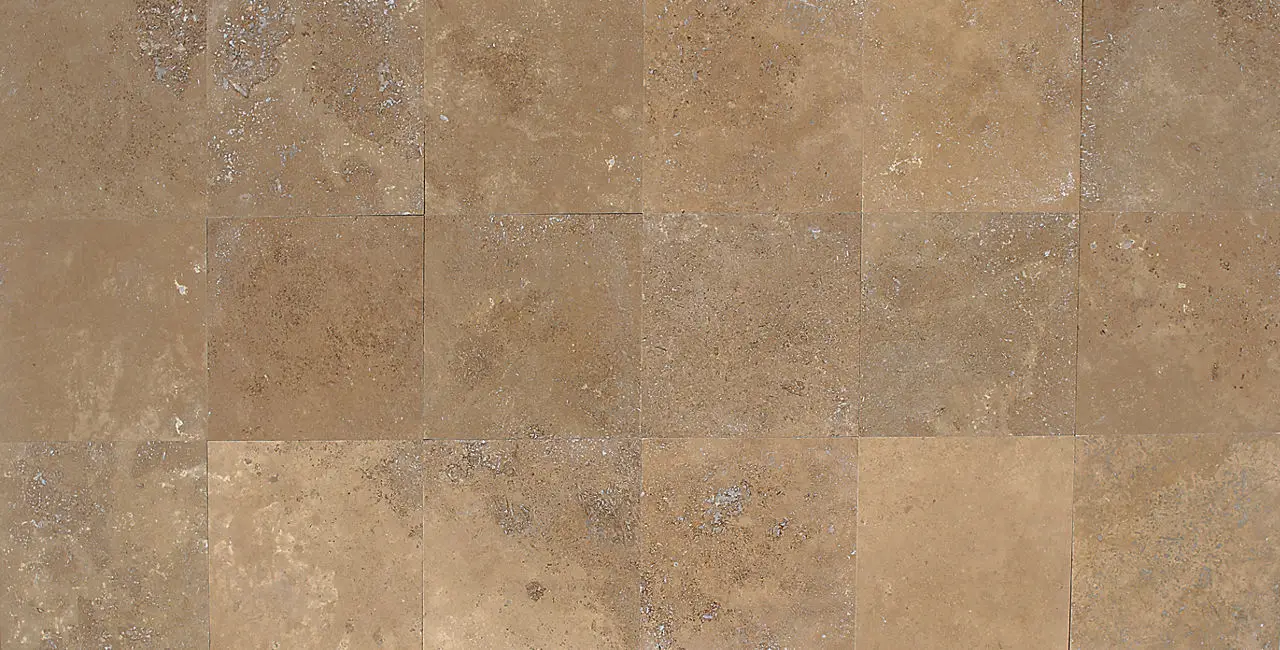 Noce Travertine, Marble Systems
Noce Travertine, Marble Systems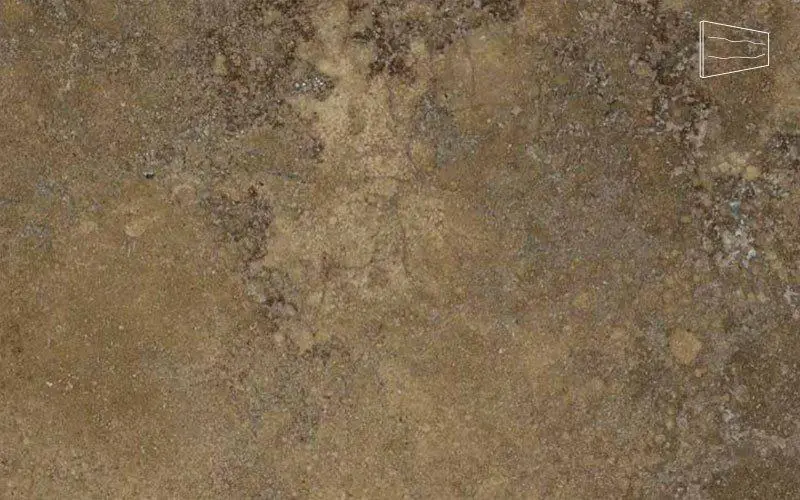 Walnut Travertine, Marmi
Walnut Travertine, Marmi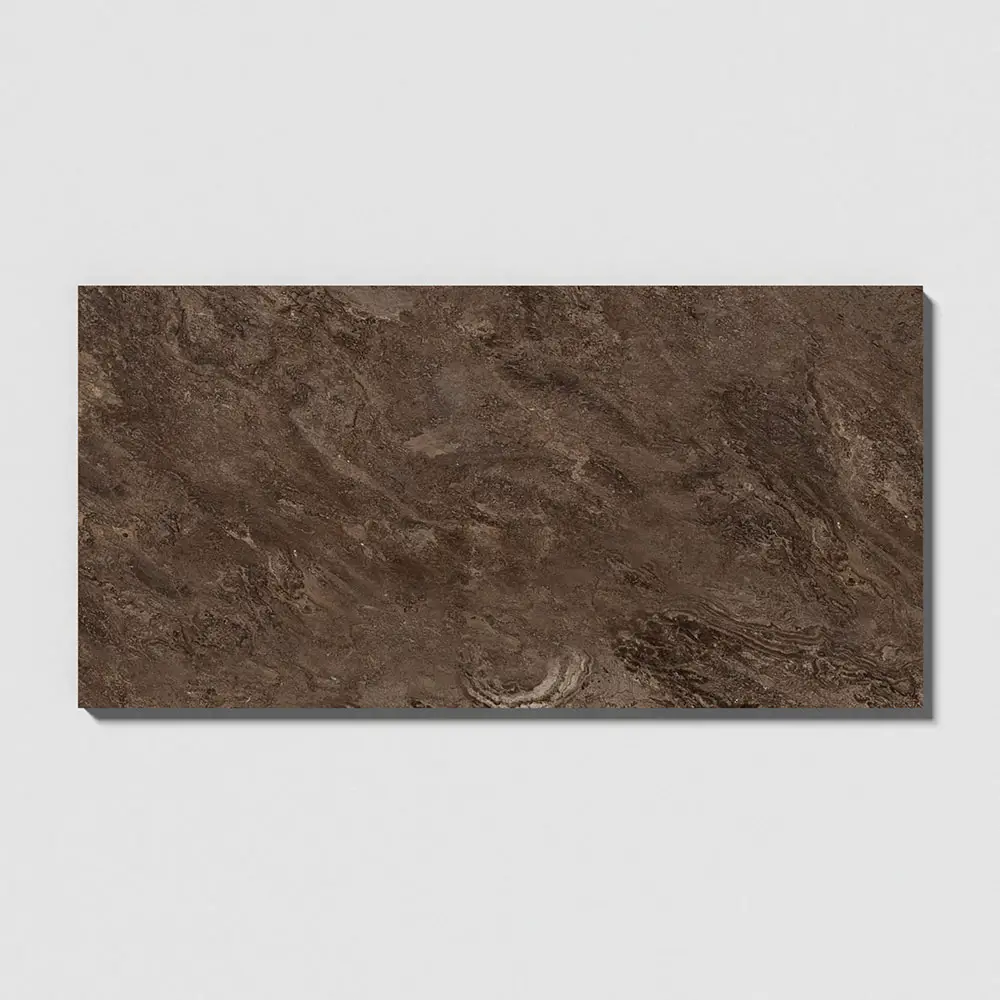 Mocha Earth Travertine, Marble Systems
Mocha Earth Travertine, Marble Systems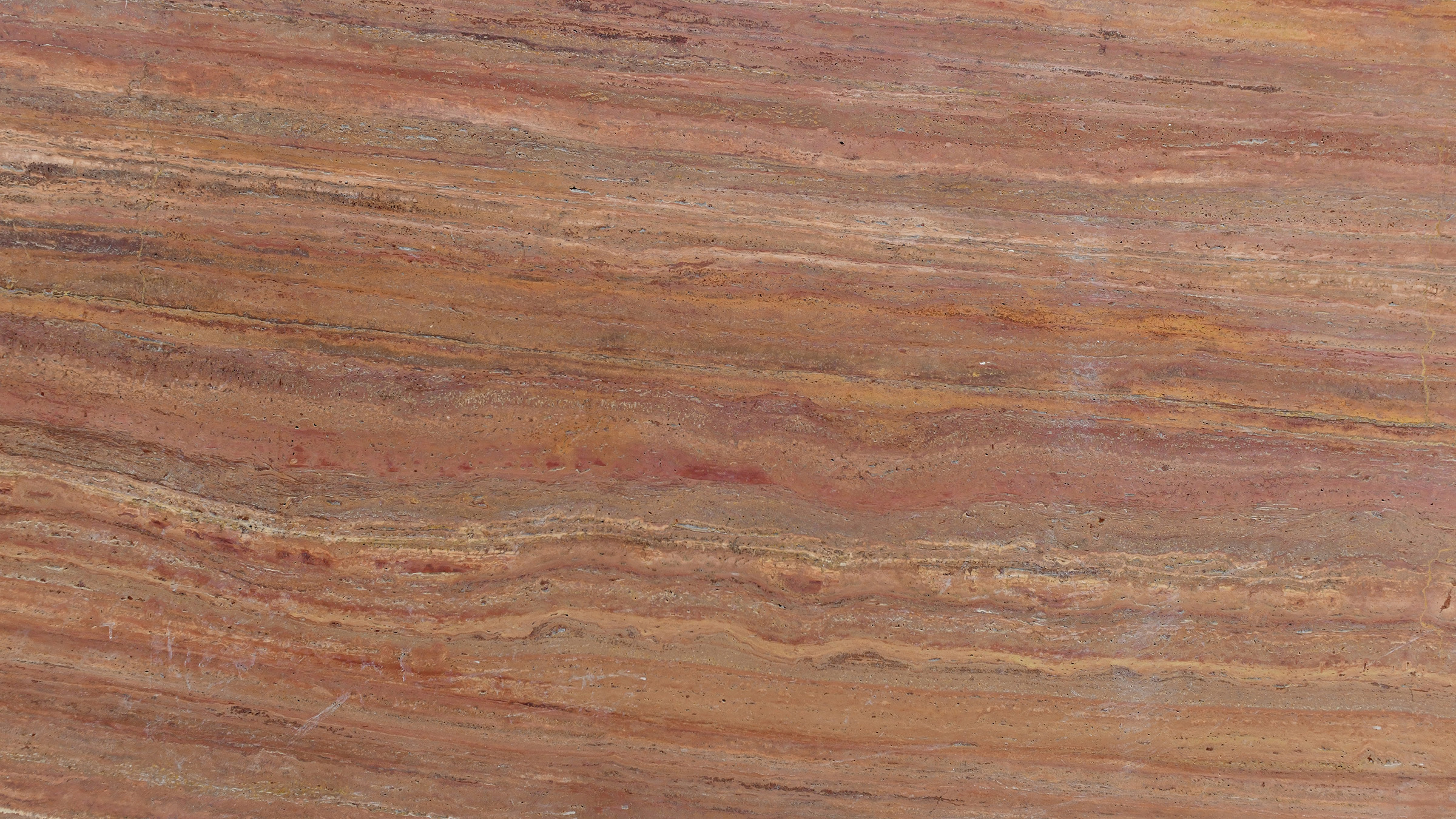 Red Travertine, NY Stone
Red Travertine, NY Stone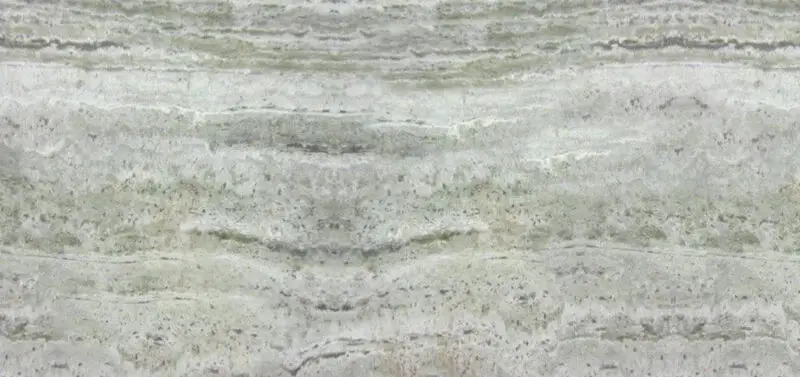 Green Travertine
Green TravertineTravertine Countertop Finishes
Travertine is available in four different surface finishes with varying degrees of shine and texture. All travertine countertops should be filled to provide a smooth, clean surface. Unfilled travertine is typically used for wall tile, backsplashes and exterior applications.
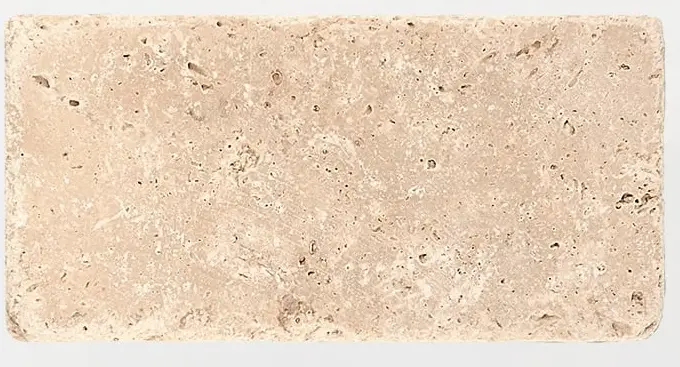 Tumbled, Unfilled Travertine, Marble Systems
Tumbled, Unfilled Travertine, Marble Systems- Polished: A shiny, elegant finish that requires the most frequent cleaning. Use this for a sleek modern look.
- Honed: A silky smooth matte finish that wears well; it’s the most popular finish for travertine countertops as it highlights the stone’s natural variations and creates spa-like calmness.
- Brushed: A textured finish that is more rough and rustic than honed, but still has crisp edges. Brushed finishes are ideal for kitchen backsplashes, bathroom floors, and outdoors.
- Tumbled: The most textured and rustic finish with worn edges and a classic old-world charm. Popular for kitchen backsplashes and indoor or outdoor flooring.
Filling the natural holes and pitting before finishing is standard for all types of travertine. However, brushed and tumbled travertine is often unfilled, or filled on site at installation.
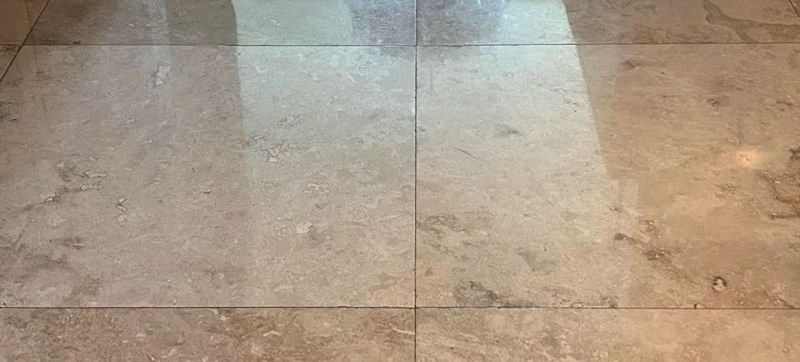 Polished Travertine Finish
Polished Travertine FinishTravertine Countertop Edge Options
Travertine suppliers usually offer edge options that are similar to other stone countertops like granite or quartzite. Depending on style and budget, homeowners may choose between rounded, squared, or fancy edges.
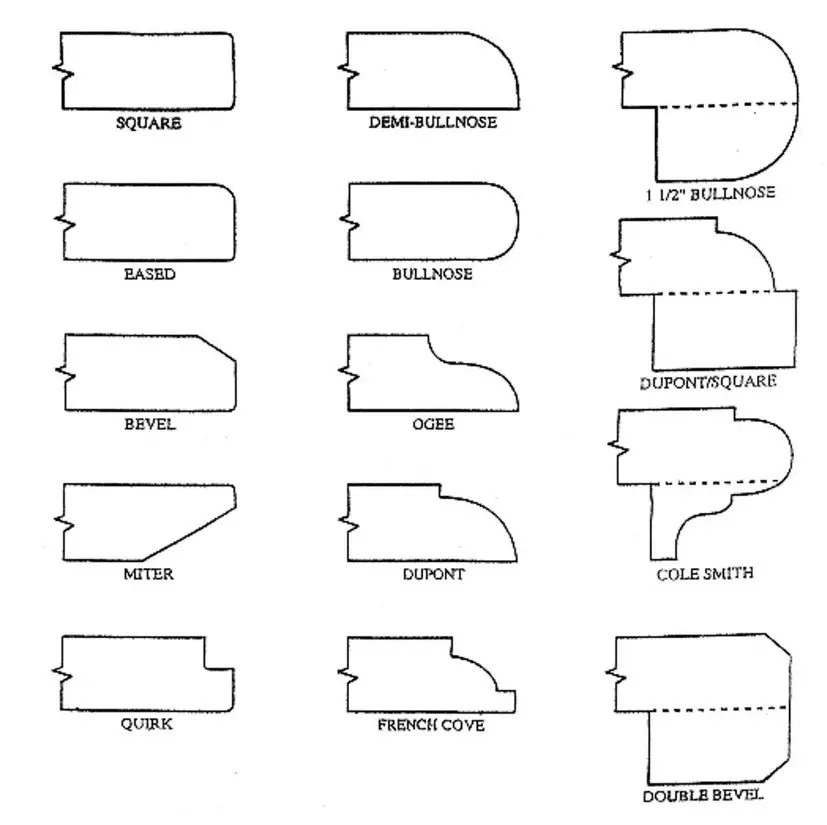
To learn more about natural stone and marble edge options, check out Edgy Ideas For Countertop Edges.
Travertine Countertop Cost
Travertine slab costs vary widely and depend on the quality of the stone, the type of cut (cross-cut vs. vein cut), the thickness of the slab, the amount of filler, and the particular finish.
In 2025, a standard cream or beige travertine countertop typically costs $40-$70 per square foot, while rare colors and patterns can be upwards of $100 per square foot.
What countertop material is similar to travertine?
Marble countertops are the most similar material to travertine. In fact, both travertine and marble come from limestone. All three stone materials share the same essential performance characteristics regarding care and maintenance.
Travertine patterns are not dramatic; they include mottled shades of color and regular vein patterns.
Marble has bolder patterning than travertine and a wide range of colors, from white, gray, and black to green, gold and red. Marble countertops are available in light, warm shades that are similar to travertine countertops.
Limestone looks most like travertine with mostly beige palette that includes some browns, grays, and blacks. The distinctive difference is that limestone has embedded marine fossils like skeletal fragments and shells of marine organisms.
Travertine and marble are the most popular types of natural stone floors as well.

Travertine vs. Marble for Countertops
Travertine and marble are essentially equal in durability and performance. Both countertop materials are prone to etching (a chemical reaction that damages the finish, leaving a dull spot). This can happen quickly from acidic foods and drinks or harsh surface cleaners. Because of this, many homeowners choose harder materials like granite, quartzite or quartz for their kitchen countertops.
Marble has a wider color range than travertine, and is available in bold, swirling patterns. Travertine is typically mottled or has layers of veining.
Travertine vs. Granite Countertops
Choosing between travertine and granite countertops is an easy decision for most homeowners, because one of these natural stone materials offers superior performance. When choosing between granite and travertine countertops, consider the following:
- Travertine has a signature look, with soft veining and warm, light colors for a classic kitchen design.
- Granite has a bold, grainy texture.
- Granite offers a broad range of colors and patterns; travertine is commonly available in shades of beige and brown.
- Granite is well-known for its hardness, with a crystalline structure that makes it extremely resistant to stains, scratches and hot pans.
- Travertine is soft and more susceptible to etching and staining.
- Granite is considered a more practical choice than travertine for busy kitchens.
- Cleaning travertine requires care, with pH-neutral cleaners and soft cloths.
- Granite tolerates a wider range of kitchen cleaners without risk of damage.
Travertine Countertops Cleaning and Maintenance
Here are some quick tips about cleaning travertine and routine care. Travertine is like marble, and it can etch, scratch, and stain.
Our Cleaning Travertine Guide provides detailed information on all aspects of maintenance.
- Seal travertine countertops frequently to protect them
- Use only non-acidic travertine cleaners (many common cleaners are too acidic)
- Do not use abrasive cleaners or pads
- Wipe up spills quickly
- Be careful not to drag heavy items across travertine countertops
Note that polished travertine requires the most care and cleaning. It readily shows dust and debris, and etch marks are more visible. Many homeowners choose honed travertine and allow it to develop a natural patina over time.
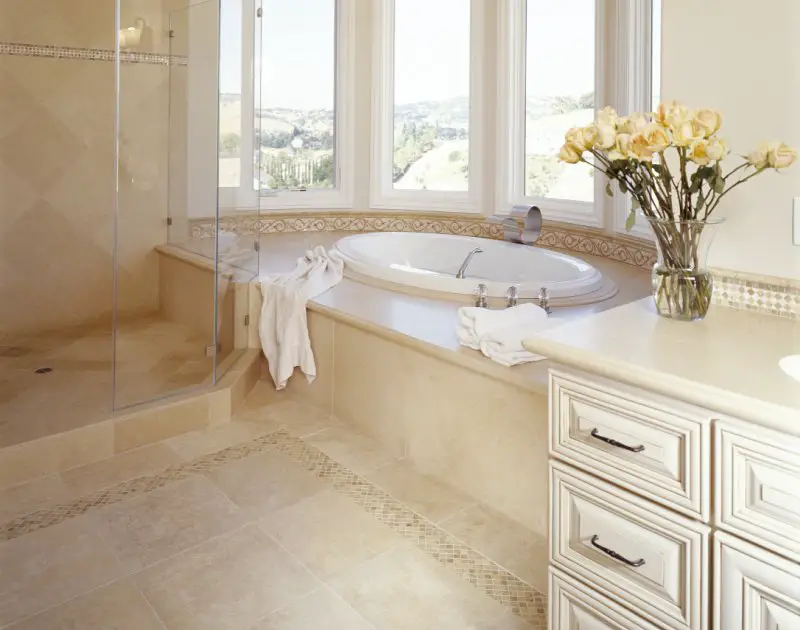 Travertine tile floor, shower, tub surround, and slab countertop
Travertine tile floor, shower, tub surround, and slab countertopTravertine Countertop FAQs
Will travertine countertops crack?
Travertine does not crack easily, so it’s a durable countertop material that’s also a good choice for outdoor kitchens. It can withstand extreme weather and freeze-thaw cycles. Dropping a heavy object on it could crack a travertine countertop, but most cracks can be filled or repaired.
Luckily, you can do most travertine repairs with DIY stone care products.
Why choose travertine countertops?
Travertine countertops are not nearly as popular as granite, quartz, or marble countertops because other countertop materials offer more color and pattern options. Recent design trends favor more dramatic colors and patterns over the more muted look of travertine countertop material. However, as interior design moves towards warm and muted shades, travertine has become an appealing countertop material once again.
What is honed and filled travertine?
Honed and filled travertine is a travertine tile or slab where all the natural holes and gaps are filled and the surface smoothed to a honed (matte) or polished (shiny) finish. It’s smoother, less porous, and more durable than unfilled travertine.
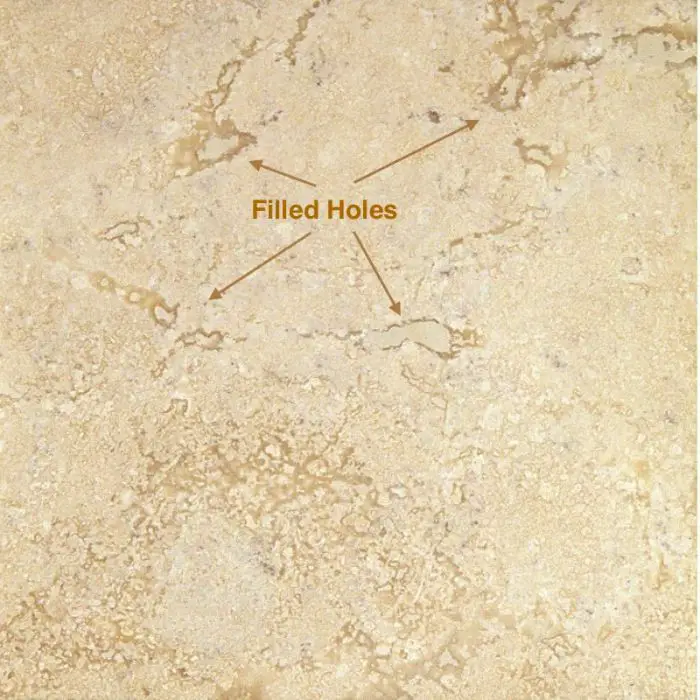
What is used to fill holes in travertine?
An epoxy filler made for travertine is used to fill holes. These naturally occurring gaps are usually filled at the factory before the slab is cut into a countertop. Epoxy travertine fillers come in colors, and can be tinted.
Can you polish travertine?
Yes, you can polish travertine to a shiny, glossy finish. Travertine polishing is done on machines at the factory or by a stone professional, but you can polish travertine and remove scratches or etch marks with DIY fine-grit polishing pads.
Can travertine be used outside?
Yes, travertine is an excellent choice for outdoor kitchens. It withstands all kinds of weather with only minor wear and will last for decades.
Can travertine be used in a bathroom?
Yes, travertine’s soft, warm tones create a luxurious spa-like feel in a bathroom. Honed or tumbled travertine provides superior slip resistance. Always seal a travertine bathroom countertop to prevent staining.


